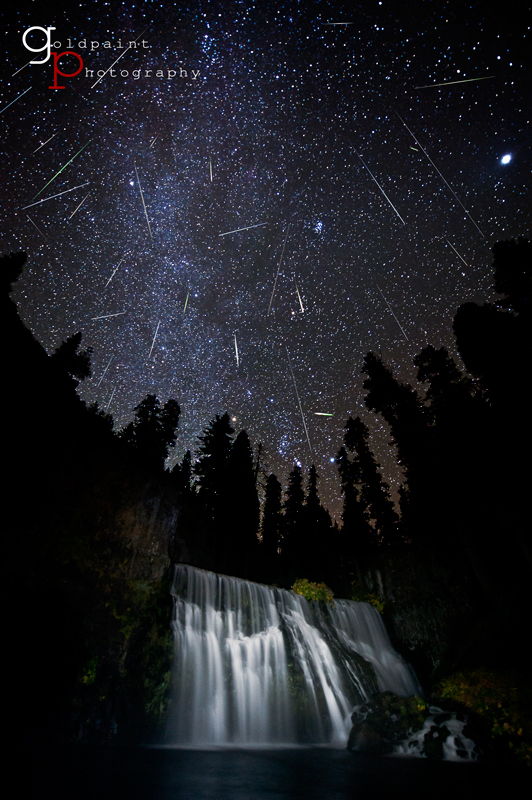Orionid Meteor Shower Spawned by Halley's Comet Peaks This Weekend

It has been 26 years since Halley's Comet last passed through the inner solar system, by this weekend skywatchers have a chance to see leftover bits of the comet light up the night sky in the Orionid meteor shower.
The Orionid meteor shower can best be described as a junior version of the famous Perseid meteor shower and is scheduled to reach its maximum before sunrise on Sunday morning (Oct. 21). Patient night sky observers with clear, dark skies could see dozens of meteors an hour, according to NASA.
This will be an excellent year to look for the Orionids, since the moon will set around 11 p.m. local time on Saturday night (Oct. 20) and will not be a hindrance at all; so the sky will be dark for prospective meteor watchers right on through the first light of dawn early Sunday morning. [Photos: Orionid Meteor Shower of 2012]
The orbit of Halley's Comet closely approaches the Earth's orbit at two places. One point is in the early part of May producing a meteor display known as the Eta Aquarids.
The other point comes in the middle to latter part of October, producing the Orionids.
Orionid meteor shower: How to watch
This weekend's meteor showeris known as “Orionids” because the meteors seem to fan out from a region to the north of well-known Orion constellation's second brightest star: the ruddy Betelgeuse.
Breaking space news, the latest updates on rocket launches, skywatching events and more!
Currently, Orion appears ahead of us in our journey around the sun, and has not completely risen above the eastern horizon until after 11 p.m. local daylight time. At its best several hours later, at around 5 a.m. — Orion will be highest in the sky toward the south — Orionids typically produce around 20 to 25 meteors per hour under a clear, dark sky.
Typically, Orionid meteors are normally dim and not well seen from urban locations, so we suggest that you find a safe rural location to see the best Orionid activity. Actually, Orionid activity started to increase noticeably on Oct. 17, when they started appearing at roughly five per hour.
After peaking on the morning of Oct. 21, activity will begin to slowly descend, dropping back to around five per hour around Oct. 25. The last few stragglers usually appear sometime in early to mid-November. [October's Best Night Sky Sights (Video)]
Recent studies have shown that about half of all Orionids that are seen leave trails that lasted longer than other meteors of equivalent brightness.
This is undoubtedly connected in some way to the makeup of Halley’s Comet. So it is that the shooting stars that we have come to call Orionids are really an encounter with the traces of a famous visitor from the depths of space and from the dawn of creation.
Halley’s Legacy
Halley's Comet takes roughly 75 years to circle the sun. But if you’re 30 years old or younger, you either have little or no memory of this famous cosmic vagabond (your next chance will come in the summer of 2061). Or maybe, if you were around back then, you didn’t see Halley at all because of light pollution or the comet's low altitude above the horizon.
That's what makes the Orionid meteor shower, and its partner the Eta Aquarids, so special: They give Earth a glimpse of Halley twice a year.
Comets are the leftovers of the day of creation, the odd bits and pieces of simple gases — methane, ammonia, carbon dioxide and water vapor — that went unused when the sun and its attendant planets came into their present form. All comets eventually disintegrate into meteor swarms and Halley’s is well into that process at this time.
These tiny particles – mostly ranging in size from dust to sand grains – remain along the original comet’s orbit, creating a “river of rubble” in space. In the case of Halley’s comet, which has likely circled the Sun many hundreds, if not thousands of times, its dirty trail of debris has been distributed more or less uniformly all along its entire orbit.
When these tiny bits of comet collide with Earth, friction with our atmosphere raises them to white heat and produces the effect popularly referred to as “shooting stars.”
Meteoroids that are released into space from this cometary debris are the remnants of a comet’s nucleus. When they hit Earth's atmosphere, they flare up in bright meteors. Any pieces that reach the Earth are called meteorites.
Editor's Note: If you snapped any photos of the Orionid meteor shower and want to share them with SPACE.com, send the pictures, comments and location info to managing editor Tariq Malik at tmalik@space.com.
Joe Rao serves as an instructor and guest lecturer at New York's Hayden Planetarium. He writes about astronomy for The New York Times and other publications, and he is also an on-camera meteorologist for News 12 Westchester, New York.

Joe Rao is Space.com's skywatching columnist, as well as a veteran meteorologist and eclipse chaser who also serves as an instructor and guest lecturer at New York's Hayden Planetarium. He writes about astronomy for Natural History magazine, Sky & Telescope and other publications. Joe is an 8-time Emmy-nominated meteorologist who served the Putnam Valley region of New York for over 21 years. You can find him on Twitter and YouTube tracking lunar and solar eclipses, meteor showers and more. To find out Joe's latest project, visit him on Twitter.

